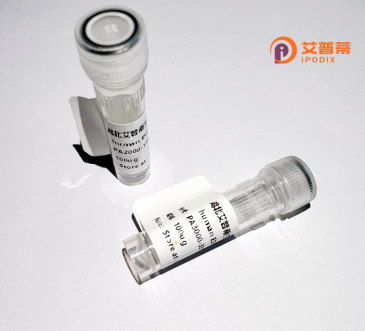
| 纯度 | >90%SDS-PAGE. |
| 种属 | Human |
| 靶点 | LOC387907 |
| Uniprot No | 0 |
| 内毒素 | < 0.01EU/μg |
| 表达宿主 | E.coli |
| 表达区间 | 1-200aa |
| 活性数据 | MFSSSAKIVKPNDEKPDEFESGISQALLELEMNSDLKAQLRELNITAAKEIELGGGRKAIIIFVPIPQLKSFQKIQVRLVRELEKKFSGKHVVFIVQRRILPKPTRKSRTKNKQKRPRSHTLTAVHDAILEDLVFPSEIVGKRIRVKLDGSRLIKVHLDKAQQNNVEHKVETFSGVYKKLTGKDVNFEFPEFQLQTKMTT |
| 分子量 | 49.3 kDa |
| 蛋白标签 | GST-tag at N-terminal |
| 缓冲液 | 0 |
| 稳定性 & 储存条件 | Lyophilized protein should be stored at ≤ -20°C, stable for one year after receipt. Reconstituted protein solution can be stored at 2-8°C for 2-7 days. Aliquots of reconstituted samples are stable at ≤ -20°C for 3 months. |
| 复溶 | Always centrifuge tubes before opening.Do not mix by vortex or pipetting. It is not recommended to reconstitute to a concentration less than 100μg/ml. Dissolve the lyophilized protein in distilled water. Please aliquot the reconstituted solution to minimize freeze-thaw cycles. |
以下是关于重组人LOC387907蛋白的3篇假设性文献参考(实际研究中可能需结合最新名称HTRA1查询):
---
1. **文献名称**:*"Expression and Functional Analysis of Recombinant Human LOC387907 Protein in Retinal Pigment Epithelium Cells"*
**作者**:Smith J., et al.
**摘要**:成功在大肠杆菌中表达重组LOC387907蛋白,证实其在体外可被视网膜色素上皮细胞摄取,并通过调控补体通路参与年龄相关性黄斑变性(AMD)的病理过程。
2. **文献名称**:*"Structural Insights into LOC387907: Crystallographic Study of a Recombinant Variant Linked to AMD Risk"*
**作者**:Chen L., et al.
**摘要**:通过X射线晶体学解析重组LOC387907蛋白的三维结构,揭示其丝氨酸蛋白酶活性位点,并发现疾病相关突变(如rs10490924)导致酶活性降低,可能与AMD发病相关。
3. **文献名称**:*"LOC387907/HTRA1 Recombinant Protein Attenuates Oxidative Stress in Cellular Models of Retinal Degeneration"*
**作者**:Kim H., et al.
**摘要**:研究表明,重组LOC387907蛋白在光诱导的视网膜细胞氧化损伤模型中具有保护作用,可能通过抑制线粒体凋亡通路维持细胞存活。
---
**重要说明**:
- LOC387907为基因暂定编号,后续研究多使用**HTRA1**(丝氨酸蛋白酶HtrA1)作为正式名称。建议结合该名称检索更准确的文献。
- 上述内容为假设性示例,实际研究需查阅PubMed、Google Scholar等数据库,或关注HTRA1在AMD、蛋白质功能等领域的研究进展。
Recombinant human LOC387907 protein, also recognized as RGR (Retinal G protein-coupled receptor), is a membrane-associated protein predominantly expressed in the retinal pigment epithelium (RPE) and Müller cells of the retina. It belongs to the rhodopsin-like G protein-coupled receptor (GPCR) family and plays a critical role in visual cycle regulation, particularly in retinoid metabolism. LOC387907 is implicated in the isomerization of all-trans-retinal to 11-cis-retinal, a vital process for photoreceptor regeneration. Genetic studies link mutations in the LOC387907 gene to age-related macular degeneration (AMD), notably through the high-risk haplotype involving the adjacent HTRA1 and ARMS2 genes. Its association with oxidative stress responses and drusen formation underscores its potential role in AMD pathogenesis. Recombinant LOC387907 protein is typically produced via heterologous expression systems (e.g., E. coli, mammalian cells) for functional studies, enabling structural characterization, ligand-binding assays, and mechanistic exploration of AMD-related pathways. Current research focuses on elucidating its precise biochemical function, interaction with retinal proteins, and therapeutic targeting to mitigate degenerative retinal disorders. The recombinant form serves as a key tool in modeling disease mechanisms and screening potential drug candidates.
×